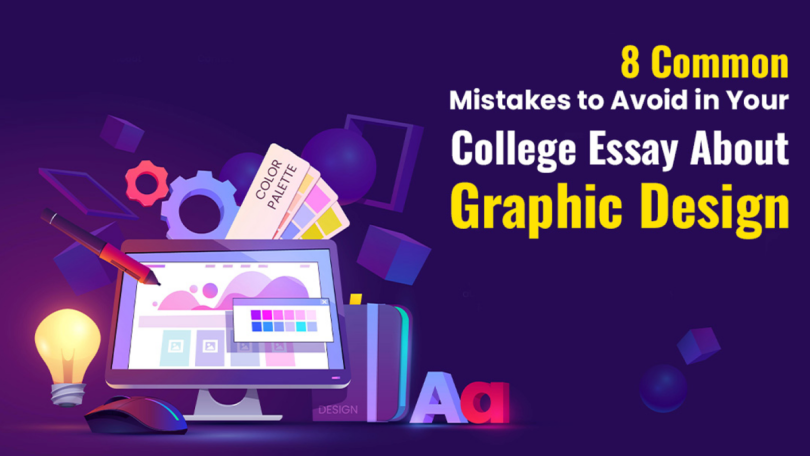This article explores some common mistakes to avoid in your college essay about graphic design. Continue reading to ensure your essay stands out and effectively showcases your skills and passion.
College essays on graphic design serve as essential platforms for students to express their creative passions, showcase personal growth, and articulate their long-term goals. They present a unique opportunity to communicate the experiences, ideas, and challenges that have shaped their journey and fuelled their passion.
However, some errors blunt the impact of your essay on graphic design, making it generic or poorly fitted to your goal. Avoid such mistakes, and rest assured that your essay will not only stand out but also narrate distinct, true stories about you and your unique potential.
In order to write an essay about graphic design, you should avoid the common pitfalls defined by the essay pros below.
What are the Common Mistakes to Avoid while Writing a College Essay about Graphic Design?
Orbit Training Centre explains that graphic design is a highly competitive field in which even the most experienced designers can commit standard basic errors that make their work useless.
For novice or less-experienced designers, understanding these pitfalls can be crucial, especially when writing college essays about graphic design. This guide will highlight nine common mistakes often found in design portfolios, offering valuable insights to help you avoid them.
1. Using Outdated Effects
You must show that you know about recent trends and sources while crafting college essays about graphic design. Ancient special effects will leave your college essay boring and give doubts about your proficiency, as well as inapplicable for your topic statement of progress.
The key points describing why and how to avoid this mistake are below.
- The lack of modern design literacy is evident in signs and effects like archaic old-timey writing,
- Using outdated methods lends the impression that your design training had been essentially completed at the undergraduate level.
- Manipulating lots of effects that may seem obsolete makes your work look like a copycat and does not earn you originality points.
- Avoid clichés like bright rainbow colour schemes, extremely stylised fonts, and embossing.
If it remains up-to-date, your essay will represent your passion, aptitude, and readiness for the discipline and rigours of a school of graphic design. It would depict you as a candidate who is not bound by the past but is pliable and enthusiastic about engaging with the future.
2. Employing Too Many Fonts
Making use of many varied fonts is not helpful and causes visual overload in your college essays about graphic design. It will make the person reading your essay lose track of the content of your paper more easily.
Moreover, the use of numerous fonts can potentially distract readers and distract them from the intended message of your story. If there are too many fonts used in the paper, the entire composition will seem disconnected, and your essay will even lack coherence. A perfect essay with solid arguments is written to express your thoughts and garner some information to prove your expertise in a subject.
These are some guidelines you must adhere to writean outstanding college essay for graphic design:
- Select a restricted colour scheme
- Use fonts frequently
- Maintain the purpose in mind
- Keep it simple
3. Poorly Executed Gradients
Your college essays about graphic design are a chance to express your skills and enthusiasm for the course. On the flip side, a poorly done gradient will run completely against your design and leave a sour taste in the admissions committee’s mouth. We talk about why you should avoid badly executed gradients in your paper.
Common Mistakes to Avoid
There are a few common mistakes with gradients you want to be on the lookout for in your college essays about graphic design.
These include:
- Gradient is one of the most versatile tools in graphic design, but using it extensively will only clutter and overpower your work.
- Test the gradient under different lighting and different devices before finalising a design.
- Too jarring or contrasting gradients with the elements in the design could be damaging to your overall focus point and draw eyes elsewhere.
- Gradients can be a tool for serenity and calmness rather than something meant for expressing movement or activity.
4. Using Stock Images
Using stock images in college essays about graphic design will water down the value of your presentation. Though they are convenient to use, there is a complete lack of originality and undermining the legitimacy of your piece. This is something admissions officers need to see: the original ideas and rationalisation, which are challenging to achieve with stock images.
One of the biggest drawbacks in working with stock photos is the generic feel that these images so often bring to a piece. Additionally, if you use photos that are accessible, then your essay probably starts to sound like one of thousands of others.
Stock photos cannot be used to express your unique design perspective because stock photos are designed to be neutral and geared towards versatility. College admissions officers prioritise problem-solving, design application, and idea exploration over mere intellectual curiosity. You will ensure that your paper communicates your authentic voice and philosophy of design by avoiding ready-made stock photographs.
5. Choosing the Wrong Colour Scheme
It’s crucial to demonstrate your grasp of design ideas and elements in college essays about graphic design. The colour scheme is one important thing to think about because it can make or break your design’s visual appeal. Regrettably, a lot of students choose the incorrect colour scheme, which can have a detrimental effect on the essay’s overall efficiency.
Why Is It Wrong to Select the Wrong Colour Scheme?
- Inconsistency in the visual harmony
- Uneven branding
- Detachment from emotions
- Challenges with reading
Take into account these pointers to prevent making this error while composing college essay graphic design:
- Recognise colour theory
- Examine and assess
- Conduct trials and evaluations
- Request feedback
6. Use an improper resolution
College essays about graphic design should reveal your abilities and present that you are aware of the topic. However, there is a common mistake everyone should avoid: an essay of wrong resolution.
Following are some points to remember:
- Understand the importance of resolution
- Do not use low-resolution photographs.
- Comprehend the normal resolutions
- Use clear photographs
- Consider the context.
Finally, using a low resolution in your graphic design college essay can be a costly mistake. The essay’s format can significantly influence admission into a good graphic design program and showcase your skills if well-structured.
7. Not Proofing the Final Design
One of the worst mistakes that can lead to failure when college essays about graphic design are submitted is neglecting to proofread the final layout. The article could have been brilliant if it had not been for grammar, spelling, or layout flaws.
Besides, such errors might ruin the foundation of your sharp concentration. The lack of attention to detail may lead admissions officials to misestimate applicants. Precision is the soul of graphic designing and should convey the same high standard in your essay.
In addition, proofreading gives you an objective view of your work so that after extensive work, you can identify mistakes and areas for improvement. Having someone read your essay can help you find some important points not aligned with your goals.
Lastly, it is worthwhile to take the time to proofread your college essay so that it reflects your creativity and commitment to excellence in graphic design.
8. Improperly Naming Files
Ensuring that even the smallest details, such as file name, are not overlooked when submitting your college essay about graphic design. Additionally, mistakes in file names can lead to miscommunication, delay, and even rejection of student applications, posing the slightest risk.
The following aspects to look out for in a college essay on graphic design include:
- File names that are concise and straightforward.
- Include your name and the title of your essay.
- Do not use any spaces or special characters.
- Use a widely used file format.
- Review it for spelling and grammar errors.
As you well know, the college application process demands a high level of attention to detail. A well-organised, properly labelled file can speak volumes to the admissions committee.
College Essay About Graphic Design Topics
Here are some interesting essay subjects on graphic design:
- Discuss how digital art was born.
- Examine the problems facing multimedia design and the current trends in online gaming.
- Regarding print publications and graphic design, do we judge a book by its cover?
- Design is the art of creating pictures out of words.
- Discuss how colour theory is put into use.
- An integral aspect of the concept of corporate branding is logos.
Conclusion
Your college essay should express your love for graphic design and your preparedness for the standards of higher education. To show admissions committees your best in your college essay about graphic design, be aware of common mistakes to avoid. Avoid committing errors and, therefore, write a fascinating essay, or seek assistance from premium collage essay writing agencies that properly showcase your creativity and technical ability.
Ultimately, writing a well-thought-out and organised college essay means so much more than showing off your imagination and creativity. It means sharing your personal opinion and narrative. In addition to demonstrating the level to which you care for your work, pay close attention to the above-listed pitfalls. The admissions officers look for your ability to think critically and solve problems when it comes to both graphic design and beyond.







